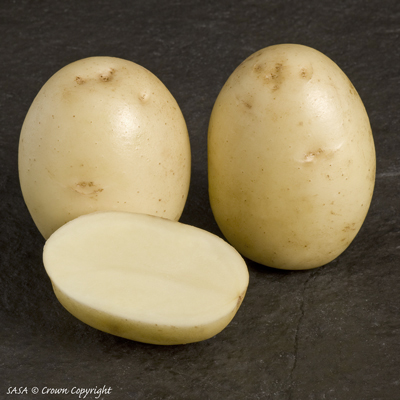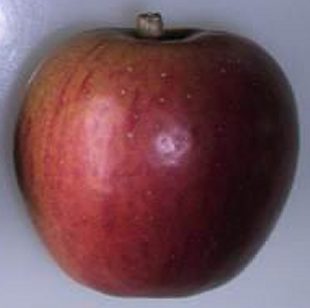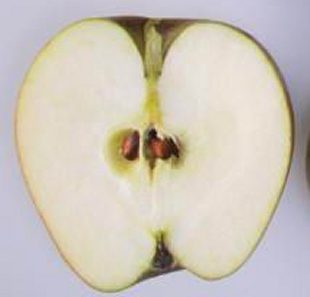PARENTAGE
The parents of Winston are Kismet x (Desiree x Maris Piper)
APPEARANCE, TASTE AND CHARACTERISTICS OF WINSTON
The Winston Potato
Winston potatoes certainly look the part with light brown skins and very few shallow eyes. Cut it in half and it still looks good with a white-cream flesh but cook it and its watery content lets it down. Disease resistance is good except for one form of eelworm and it bulks up quickly. The plants are relatively short growing so would still do well in windy conditions.
POSITIVE POINTS FOR WINSTON
Winston is a first-early variety which bulks up quickly. The potatoes looks good and are great for exhibition purposes.
NEGATIVE POINTS FOR WINSTON
Flavour is lacking and the flesh has a watery consistency when cooked. Not a variety we would recommend if flavour is important to you.
BUYING WINSTON SEED POTATOES IN THE UK
Winston is a common variety of potato which is readily available online and sometimes in garden centres.
We recommend buying your seed potatoes from certified suppliers because those sold in supermarkets for consumption can be a source of disease and pest. We would avoid buying them from online general retailers such as as Amazon or E-bay unless you know exactly who is supplying the seed potatoes.
Buying seed potatoes from the discount store can be a good deal but it can also result in a sub-standard crop. The discount stores take the second quality seed potatoes whereas the more specialist suppliers take the best quality. Unfortunately you will only find this out after you have carefully tended your crop for several months.
Crocus (a GardenFocused approved supplier) sell Winston seed potatoes (and many other varieties) which are not only correctly certified but they are graded by size to avoid unduly small seed potatoes being sold. Click here for more information and to buy Winston online. A 2kg bag will contain about 22 good sized seed potatoes.
ALTERNATIVES TO ARRAN PILOT POTATOES
For other potato varieties which we have fully reviewed, click the drop down box below, select a variety and then click the More Information Button.
The planting and harvest dates used below are correct for the UK average. If you want them to be even more accurate and adjusted for your area of the UK click here. It only takes a minute and the adjustment affects every date in this site and lasts for six months.
WHEN TO CHIT / SPROUT WINSTON POTATOES
We recommend that you start chitting / sprouting Winston potatoes in. the third week of February This will give them four to five weeks to develop healthy sprouts just at the time when they are ready to be planted out. Keep the potatoes in cool but light conditions to ensure they grow short, green sprouts. Click here for our page dedicated to chitting / sprouting potatoes in the UK and Ireland.
WHEN TO PLANT WINSTON POTATOES
Winston potatoes are first early potatoes and they are ready for harvest, if conditions are correct, 12 to 14 weeks after the seed potatoes are planted. The key factor governing the time for planting all potatoes is the date of the last frost in your area. Even a touch of frost can damage potato plants if their foliage is above ground, an unexpected severe frost can kill them completely.
The date for planting Winston seed potatoes can be calculated on the basis that seed potatoes will take four weeks before they appear above ground. Given also that you want them to appear above ground only when the danger of frost has passed (the last week of April is the UK average the last week of March is about right time to plant them.
WHEN TO HARVEST WINSTON POTATOES
The harvest date for all potatoes is not only dependent on when you plant your seed potatoes, it also depends on the weather conditions throughout the growing season. But on average you can expect your Winston potatoes to be ready for harvest some time between the last week of June and the second week of July in your area of the UK.
BUYING WINSTON SEED POTATOES IN THE UK
Winston is not one of the commonest seed potatoes but is easily found online, and can sometimes be found at garden centres.
We recommend buying your seed potatoes from certified suppliers because those sold in supermarkets for consumption can be a source of disease and pest. We would avoid buying them from online general retailers such as as Amazon or E-bay unless you know exactly who is supplying the seed potatoes.
PEST AND DISEASE RESISTANCE OF WINSTON POTATO
The table below sets out how good or bad Winston potato plants are at resisting common pests and diseases in the UK. The 0 point is average with minus (red) values showing lower than average resistance and plus values (green) showing higher than average resistance.
| -5 | -4 | -3 | -2 | -1 | 0 | +1 | +2 | +3 | +4 | +5 | |
| Late blight – foliage |
|||||||||||
| Late blight – tubers |
|||||||||||
| Common scab |
|||||||||||
| Powdery scab |
|||||||||||
| Slugs |
|||||||||||
| Potato Cyst Nematode (pallida) |
|||||||||||
| Potato Cyst Nematode (rostochiensis) |
|||||||||||
| Blackleg |
|||||||||||
| Splitting |
|||||||||||
| -5 | -4 | -3 | -2 | -1 | 0 | +1 | +2 | +3 | +4 | +5 |
SUMMARY CHARACTERISTICS OF WINSTON
USE: Baking, boiling and roasting – watery flesh and little taste
SKIN COLOUR / TEXTURE: Light brown, smooth with shallow eyes
FLESH COLOUR: Cream
TASTE AND TEXTURE: Lacks taste and texture
STORAGE: Poor storage qualities
POTATO SIZE: Average to large
REGULARITY OF CROPPING: Regularly produces a good yield
AWARDS: None
SPECIAL FEATURES: None



How to Grow Potatoes
Recommended Varieties
How to Chit / Sprout
Planting Seed Potatoes
Caring for Potatoes
Harvesting and Storing
Potatoes in Containers
Pest and Disease
WINSTON POTATO
If you read the write-ups from the seed merchants they would have you believe that Winston is a first early which quickly bulks up to the size and quality of a maincrop. Yes, it does bulk up quickly but at the expense of taste and texture. It is a watery potato variety and not one we would recommend for regular use in the kitchen.
Looks however are a different matter and if you want a good looking potato early on in the season for exhibition then Winston will suit your needs admirably.